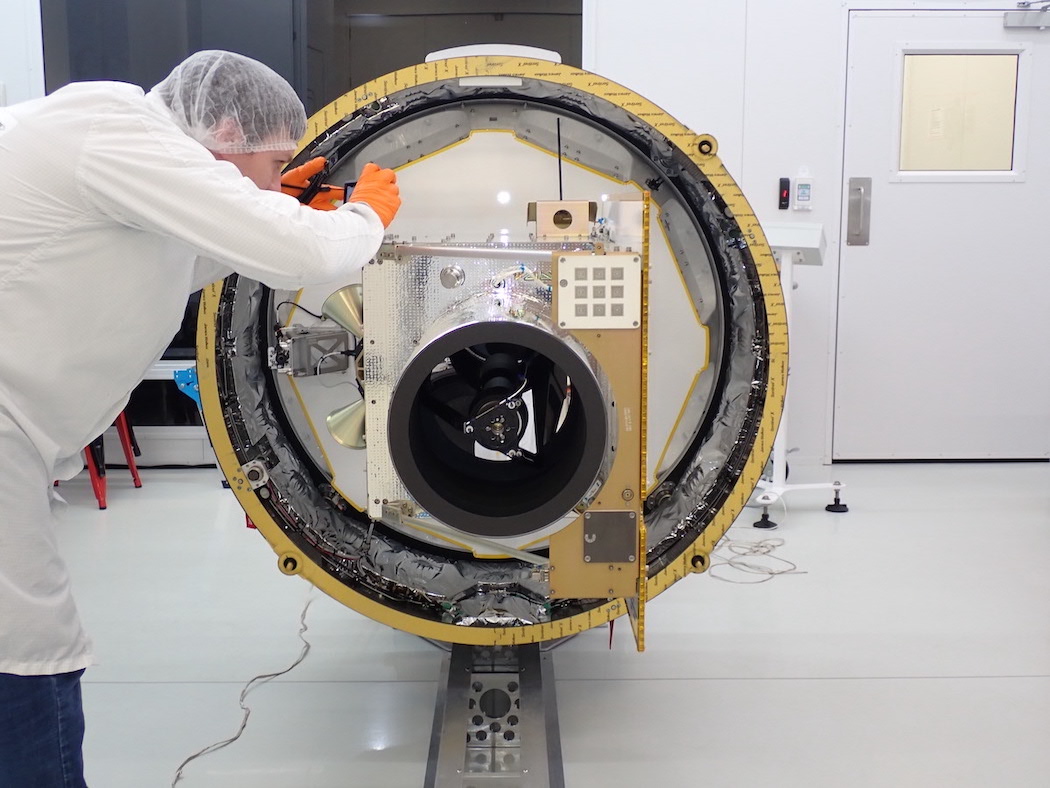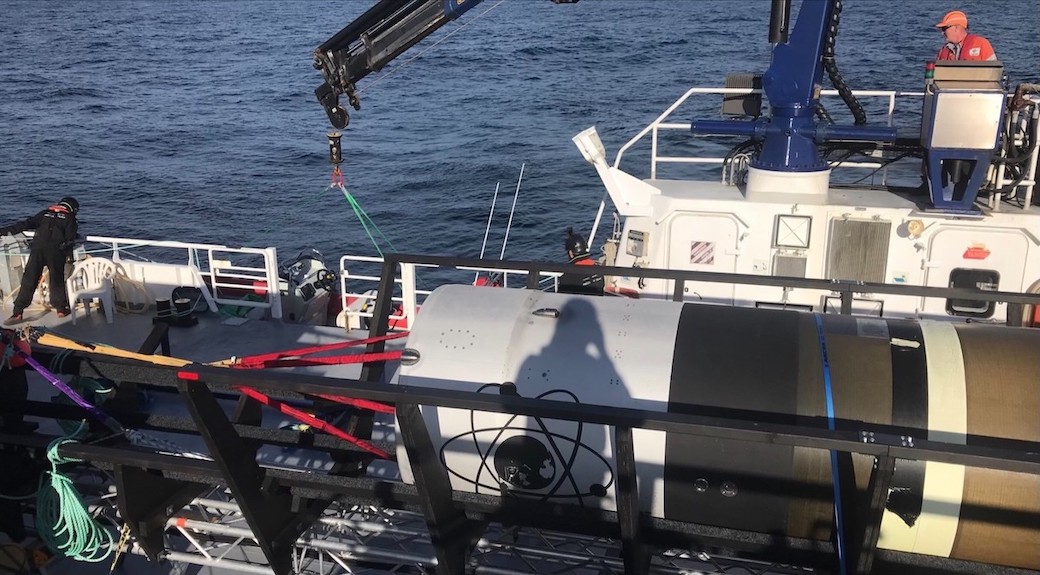
Rocket Lab launched two small BlackSky optical Earth-imaging satellites Wednesday from New Zealand, the first of three straight Electron rocket flights for the U.S. remote sensing company.
Teams retrieved the launch vehicle’s first stage booster after parachuting into the sea. It was the third time Rocket Lab has recovered a booster from the Pacific Ocean.
This time, Rocket Lab deployed a helicopter to the recovery zone around 230 miles (370 kilometers) east of the launch site in New Zealand. The aircraft tracked the carbon fiber booster stage as it descended under its main parachute, practicing for a future mission when the helicopter will try to catch the rocket in mid-air.
An airborne recovery will prevent salt water from damaging the rocket, allowing teams to refurbish and reuse the booster.
Wednesday’s recovery test downrange occurred as the Electron’s second stage and kick stage fired into orbit with the twin BlackSky satellites.
The mission began with liftoff from Rocket Lab’s commercial spaceport at Mahia Peninsula on the North Island of New Zealand at 8:38:13 p.m. EST Wednesday (0138:13 GMT; 2:38 p.m. New Zealand time Thursday).
Nine kerosene-fueled Rutherford engines propelled the 59-foot-tall (18-meter) rocket into a clear spring sky over the Pacific Ocean. Heading east, the rocket shed its first stage two-and-a-half minutes after liftoff, then ignited a single Rutherford engine on the second stage to accelerate into a parking orbit around Earth.
Here’s a replay of the 22nd launch of Rocket Lab’s Electron booster from New Zealand. This mission is carrying two BlackSky Earth observation satellites into orbit. https://t.co/Qxxd3HJUW1 pic.twitter.com/rQzf8eyYLu
— Spaceflight Now (@SpaceflightNow) November 18, 2021
The jettisoned first stage, meanwhile, coasted to an apex in its ballistic trajectory and then fell back into the atmosphere, withstanding temperatures as high as 4,000 degrees Fahrenheit (2,200 degrees Celsius).
The booster opened a main parachute to slow down for the final phase of its descent toward the Pacific Ocean, splashing down nearly 20 minutes after launch.
The Electron’s kick stage separated from the second stage about 10 minutes into the mission. After coasting halfway around the world, the kick stage ignited its Curie thruster to circularize its orbit at a target altitude of 267 miles (430 kilometers), with an inclination of 42 degrees to the equator.
The two BlackSky satellites, each about 121 pounds (55 kilograms), were stacked one on top of the other on the Rocket Lab kick stage. The company slightly enlarged the payload volume under the Electron rocket’s nose cone to accommodate the dual payloads.
The upper satellite separated first, followed by release of a “top hat” adapter structure to reveal the lower spacecraft for deployment. After both satellites were off the rocket, the kick stage reignited for a deorbit burn to prevent it from creating a new piece of space junk.
Peter Beck, Rocket Lab’s founder and CEO, heralded the mission as a “perfect flight.”
“Today’s launch was a masterclass from an incredible team of engineers on how to successfully deliver customers’ satellites to space while at the same time demonstrating cutting-edge operations and innovation that pushes the space industry forward on small rocket reusability,” Beck said in a statement. “This is our third successful proof of concept recovery mission, and further cements Electron as the leading launch vehicle for the small satellite market.
“We are all excited to move onto the next phase of reusability next year; catching Electron in the air with a helicopter,” Beck said.

The mission Wednesday also debuted an advanced parachute for the returning first stage booster, plus upgrades to the heat shield to protect the rocket’s nine main engines.
Rocket Lab’s Electron launcher is sized to deliver small satellites to orbit, providing a dedicated ride for spacecraft that would otherwise have to fly as a lower-priority payload on a larger launch vehicle.
The Electron rocket has about 1% of the lift capability of a SpaceX Falcon 9 launcher, the only partially reusable rocket currently operational. Rocket Lab, which sells dedicated Electron missions for as little as $7 million, aims to join SpaceX on that short list.
This mission was the first of three Rocket Lab flights in a row for BlackSky, each carrying a pair of remote sensing satellites. The next launch is scheduled for a window opening in December.
BlackSky, with offices in Seattle and Herndon, Virginia, is deploying a fleet of small remote sensing satellites to provide high-resolution Earth imagery to commercial and government clients.
One big customer for BlackSky is the U.S. military and intelligence agencies. BlackSky has agreements to sell commercial imagery to NASA, the National Reconnaissance Office and the National Geospatial-Intelligence Agency.

BlackSky’s satellites are built by LeoStella, a joint venture between Spaceflight Industries and Thales Alenia Space, a major European satellite manufacturer. LeoStella’s production facility is located in Tukwila, Washington, a suburb of Seattle.
Rocket Lab and BlackSky announced an agreement earlier this year for five Electron launches to carry the next nine BlackSky satellites into orbit.
The first launch in the multi-mission contract successfully deployed a single BlackSky payload into orbit in March. The second of the five missions in May failed before reaching orbit due to a malfunction in the Electron rocket’s second stage. The two BlackSky satellites on-board crashed back to Earth, a loss the company valued at $18.4 million, including the spacecraft and launch services.
Wednesday’s flight marked the third mission under the multi-launch agreement. The next two missions will complete the five-launch contract between Rocket Lab and BlackSky. Spaceflight, a Seattle-based rideshare company, brokered the launch agreement for BlackSky.
Including the two spacecraft deployed Wednesday, nine BlackSky satellites have successfully launched since 2018, following a 2016 launch that deployed a technology demonstration satellite for the company. BlackSky said earlier this month it has six satellites in commercial operations.
Email the author.
Follow Stephen Clark on Twitter: @StephenClark1.
